Why a Clean Email List is Important
Sending emails to a clean list is better for your business. First, it helps your emails get to the right people. If you send emails to bad addresses, they will bounce back. Too many bounces can make email companies like Google think you are a spammer. This can hurt your reputation. As a result, your good emails might end up in the spam folder. Second, a clean list saves you money. Many email marketing services charge you based on how many subscribers you have. If you are paying for thousands of bad addresses, you are wasting money. Third, a clean list gives you better data. You can see how many people are opening your emails and clicking your links. This information is more accurate when your list is clean.
What Do These Tools Do?
Email list management tools help you keep your list clean and organized. They do this in many ways. For instance, some tools can verify email addresses. This means they check to see if an email address is real. They can tell you if an email is fake or no longer works. This helps you get rid of bad addresses right away. Other tools can help you organize your list into different groups. This is called "segmentation." You can group people by their interests or how they have interacted with your business. This lets you send more president email lists targeted emails. Still others can help you remove people who have not opened your emails in a long time. These people are often not interested anymore.

The Problem with "Dirty" Email Lists
A "dirty" email list is one that has many bad or inactive addresses. This can cause a lot of problems for your business. For example, a dirty list can lead to high bounce rates. A high bounce rate tells email providers that you are not being careful about who you email. This can hurt your "sender reputation." It might cause your emails to be flagged as spam. Furthermore, a dirty list can waste your time. You might be spending time creating emails for people who will never see them. Finally, a dirty list gives you bad data. You might think your emails are not working, when in reality, they are just not getting to the people on your list.
How Email Verification Tools Work
Email verification tools are a key part of list management. They work by checking each email address on your list. They look for things like typos and fake domains. They also check if the email address is connected to a real inbox. This process helps you find and remove bad email addresses. Some tools do this in real time. For example, when someone types their email into your sign-up form, the tool can check it right away. If it's a fake email, the person cannot sign up. This helps you keep a clean list from the very beginning. Using a good verification tool can save you a lot of trouble.
Using Segmentation to Personalize Emails
Segmentation is another important feature of these tools. It is the process of dividing your list into smaller, more specific groups. For example, you can group your subscribers by what they have bought from you. You can also group them by where they live. You can even group them by how often they open your emails. This lets you send more personal messages. Instead of sending the same email to everyone, you can send different emails to different groups. This makes your messages more relevant to each person. More relevant emails often get more opens and clicks. Consequently, this can lead to more sales.
Removing Inactive Subscribers
It is a good idea to remove people who have not engaged with your emails in a long time. These are "inactive" subscribers. An inactive subscriber is someone who has not opened or clicked your emails in six months or a year. Keeping them on your list can hurt your sender reputation and cost you money. Many email list management tools can help you find these inactive people. You can try to send them a final email to see if they are still interested. If they don't respond, you can remove them from your list. This is a healthy practice for a good email list.
Choosing the Right Tool
When choosing an email list management tool, you should look at a few things. First, consider the features it offers. Does it have email verification? Does it offer good segmentation? Second, look at the price. Some tools are expensive, while others are more affordable. Think about your budget and what you need. Third, read reviews from other users. See what people are saying about the tool's performance and customer support. Finally, check if the tool integrates with your current email marketing service. This will make it easier to use. A good tool will help you save time and money in the long run.
Conclusion
Email list management tools are essential for any business that uses email marketing. They help you keep your list clean and organized. By using these tools, you can improve your sender reputation and get better results from your email campaigns. They help you get rid of bad addresses, segment your audience, and remove inactive subscribers. This leads to more effective, more personalized emails and better returns for your business. Investing in a good email list management tool is a smart move for your marketing efforts.